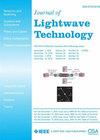Reaching the Peta-Computing: 163.8 TOPS Through Multidimensional AWGR-Based Accelerators
IF 4.1
1区 工程技术
Q2 ENGINEERING, ELECTRICAL & ELECTRONIC
引用次数: 0
Abstract
The prowess of Artificial Intelligence (AI) and Large Language Models (LLMs) to compute the exponentially growing data, coupled with the digital electronic AI computing systems reaching their physical plateaus, have stimulated extensive research into next-gen AI accelerators. Optical Neural Networks (ONNs) have been among the most favored candidates, since the unparalleled speed of light can provide massive compute parallelism by the physical dimensions of time, wavelength, and space, offering higher computational speeds and lower power consumption. In this paper, we experimentally demonstrate novel time-space-wavelength multiplexed arrayed waveguided gratings router (AWGR)-based architectures exploited as photonic matrix- and tensor-multiplier engines achieving a total computational power of up to 163.8 TOPS. This marks a substantial ∼15x improvement over state-of-the-art waveguide-based optical accelerators. The two demonstrators were tested for three different NN applications, under two experimental testbeds. The matrix-multiplier was evaluated as a fully connected NN (FCNN), classifying images from the FMNIST dataset. An 8 × 8 AWGR was employed for providing the passive routing, with modulators driven at 10Gbaud, exhibiting a hardware-based inference accuracy of 87.1% with respect to the software. The tensor-multiplier, using a 16 × 16 AWGR, was evaluated as a FCNN and a convolutional NN (CNN), detecting DDoS attacks and classifying handwritten digits at 20 Gbaud. The experimental results exhibited a Cohen's kappa score of 0.799 for the DDoS detection and a classification accuracy of 93.35%, respectively.求助全文
约1分钟内获得全文
求助全文
来源期刊

Journal of Lightwave Technology
工程技术-工程:电子与电气
CiteScore
9.40
自引率
14.90%
发文量
936
审稿时长
3.9 months
期刊介绍:
The Journal of Lightwave Technology is comprised of original contributions, both regular papers and letters, covering work in all aspects of optical guided-wave science, technology, and engineering. Manuscripts are solicited which report original theoretical and/or experimental results which advance the technological base of guided-wave technology. Tutorial and review papers are by invitation only. Topics of interest include the following: fiber and cable technologies, active and passive guided-wave componentry (light sources, detectors, repeaters, switches, fiber sensors, etc.); integrated optics and optoelectronics; and systems, subsystems, new applications and unique field trials. System oriented manuscripts should be concerned with systems which perform a function not previously available, out-perform previously established systems, or represent enhancements in the state of the art in general.
 求助内容:
求助内容: 应助结果提醒方式:
应助结果提醒方式:


